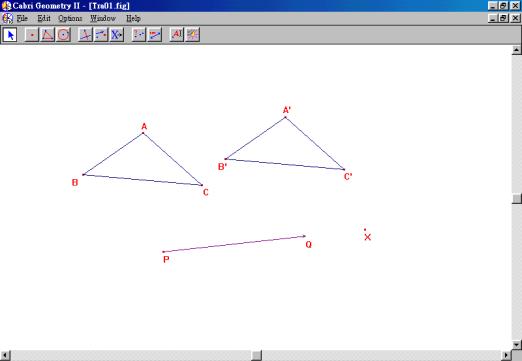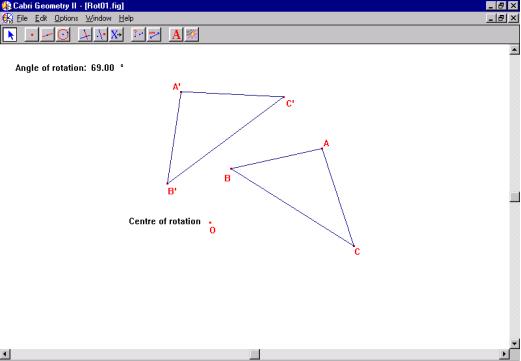Objective:To Recognize the Effect of Transformation Including Translation, Rotation And

/ EXEMPLAR 10:
Transformation on 2-D Shapes
Objective:To recognize the effect of transformation including translation, rotation and reflection on 2-D shapes
Key Stage: 3
Learning Unit: Transformation and Symmetry
Materials Required: Dynamic geometry software such as Cabri Geometry II and files Tra01.fig, Rot01.fig and Ref01.fig.
Prerequisite Knowledge: Meaning of transformation including translation, rotation and reflection
Description of the Activity:
- The teacher recalls students the concept of transformation including translation, rotation and reflection. During the discussion, the teacher points out the meaning of a vector in translation, the centre of rotation and the line of reflection to students. (Note: If students have difficulty in understanding the term "vector", the term "arrow" could be used instead.)
- The teacher raises the question whether the shape and size of the 2-D shape preserve under the above transformation.
- The teacher distributes Worksheet 1 to students.
- The teacher briefly explains how to use the Cabri file Tra01.fig to complete the investigation in Worksheet 1.
- Students need to use the Cabri file to do their own investigation on the effect of translation on a triangle and other 2-D shapes.
- The teacher invites some students to present their findings and conjectures to the whole class. Others can make appropriate comments.
- The teacher helps students to draw the conclusion that the lengths, the angles, the perimeter and the area of the 2-D shape preserve under translation.
- The teacher distributes Worksheet 2, Worksheet 3, Cabri files Rot01.fig and Ref01.fig to students. Students have to follow instructions of the worksheets to do their investigation on the effects of rotation and reflection on triangle and other 2-D shapes and make corresponding conjectures.
- The teacher asks some students to explain their findings to the whole class. The teacher can give appropriate comment during the explanation.
- The teacher guides students to conclude that the lengths, the angles, the perimeter and the area of the 2-D shape preserve under rotation and reflection.
Worksheet 1: Translation of 2-D Shapes

Open the Cabri file Tra01.fig. You will find a ABC, a vector PQ with a controlling point X. The point X controls the direction of the vector PQ whereas the point Q controls the magnitude of the vector. A'B'C' is the image of ABC under the translation by the vector PQ (Fig.1).
Fig.1
- Do the following investigations and write down your observations in Table 1 (no need to do any measurement).
(a)Drag each of the vertices of the ABC to change the shape of the triangle.
(b)Drag the end point Q of the vector to other position.
(c)Drag the controlling point X to change the direction of the vector PQ.
(d)Drag the controlling point X and then drag the end point Q of the vector again.
Action / Has A'B'C' the same shape as ABC? / Has A'B'C' the same size as ABC?(a) / Change in the shape of ABC.
(b) / Change in the magnitude of the vector PQ.
(c) / Change in the direction of the vector PQ.
(d) / Change in the direction of the vector PQ and then change in the magnitude of the vector PQ.
Table 1
- Repeat point 2. Measure the lengths, the angles, the perimeters and the areas of the two triangles. Are there changes among these measurements under translation? Has A'B'C' the same shape as ABC? Has A'B'C' the same size as ABC?
______
- Clear ABC. Use the same Cabri file to draw any 2-D figure as you like (e.g. rectangle, trapezium, etc). Translate the 2-D figure by the vector PQ. (See Annex for the Operation Procedure.)
Measure the angles and lengths of the 2-D figures and its image to complete Table 2.
Action / Has the 2-D figure the same shape as its image? / Has the 2-D figure the same size as its image?(a) / Change in the shape of the 2-D figure.
(b) / Change in the magnitude of the vector PQ.
(c) / Change in the direction of the vector PQ.
(d) / Change in the direction of the vector PQ and then change in the magnitude
Table 2
Worksheet 2: Rotation of 2-D Shape

Open the Cabri file Rot01.fig. You will find a ABC, a centre O of rotation and an angle of rotation. A'B'C' is the image of ABC under the rotation about the centre O with respect to the given angle (Fig.1).
Fig.1
- Do the following investigations and write down observations in Table 1 (no need to do any measurement).
(a)Drag each of the vertices of the ABC to change the shape of the triangle.
(b)Double click the angle of rotation. You will find the arrow keys appear on the right hand side of the angle. Press the arrow up key or the arrow down key to modify the angle of rotation. The image A'B'C' will then rotate according to the angle of rotation.
(c)Drag the point O to another position to observe the change.
(d)Drag the point O to another position. Repeat step (b) to rotate the figure again.
Action / Has A'B'C' the same shape as ABC? / Has A'B'C' the same size as ABC?(a) / Change in the shape of ABC.
(b) / Change in the angle of rotation.
(c) / Change in the centre of rotation O.
(d) / Change in the angle of rotation with respect to different positions of centre O.
Table 1
- Repeat point 2. Measure the lengths, the angles, the perimeters and the areas of the two triangles. Are there changes among these measurements under rotation? Has A'B'C' the same shape as ABC? Has A'B'C' the same size as ABC?
______
- Clear ABC. Use the same Cabri file to draw any 2-D figure as you like (e.g. rectangle, trapezium, etc). Rotate the 2-D figure with respect to the centre O through a given angle. (See Annex for the Operation Procedure.)
Measure the angles and lengths of the 2-D figures and its image to complete Table 2.
Action / Has the 2-D figure the same shape as its image? / Has the 2-D figure the same size as its image?(a) / Change in the shape of the 2-D shape.
(b) / Change in the angle of rotation.
(c) / Change in the centre of rotation.
(d) / Change in the angle of rotation with respect to different positions of centre O.
Table 2
Worksheet 3: Reflection of 2-D Shape

Open the Cabri file Ref01.fig. You will find a ABC, a line L and a point P lying on the line. The position of the line L can be controlled by dragging the point P. A'B'C' is the image of the ABC under the reflection by the line L (Fig.1).
Fig.1
- Do the following investigations and write down your observations in Table 1 (no need to do any measurement).
(a)Drag each of the vertices of ABC to change the shape of the triangle.
(b)Drag the line L to another direction.
(c)Drag the point P to another position.
(d)Drag the point P to another position and drag the line L to another direction.
Action / Has A'B'C' the same shape as ABC? / Has A'B'C' the same size as ABC?(a) / Change in the shape of ABC.
(b) / Change in the direction of the line L.
(c) / Change in the position of the point P.
(d) / Change in the position of the point P and then the direction of the line L.
Table 1
- Repeat point 2. Measure the lengths, the angles, the perimeters and the areas of the two triangles. Are there changes among these measurements under reflection? Has A'B'C' the same shape as ABC? Has A'B'C' the same size as ABC?
______
- Clear ABC. Use the same Cabri file to draw any 2-D figure as you like (e.g. rectangle, trapezium, etc). Reflect the 2-D figure with respect to the line L. (For the Operation Procedure, see Annex.)
Measure the angles and lengths of the 2-D figure and its image to complete Table 2.
Action / Has 2-D figure the same shape as its image? / Has 2-D figure the same size as its image?(a) / Change in the shape of the 2-D figure.
(b) / Change in the direction of the line L.
(c) / Change in the position of the point P.
(d) / Change in the position of the point P and then the direction of the line L.
Table 2
Notes for Teachers:
- The transformation on 2-D shapes includes in this exemplar are translation, rotation and reflection only. The transformations of dilation and contraction are not included here. Please refer to Exemplar 1 in "Teaching Package on S1-5 Mathematics 1: Use of Information Technology" produced by the Mathematics Section of Education Department in 2001 for the activity of dilation/contraction.
- The suggested time ratio for the learning unit "Transformation and Symmetry" is 6 periods. So teachers may let students attempt the investigation in question 4 of each worksheet after lesson or for demonstration only.
- For more able students, the teacher can introduce other types of transformation such as glide reflection, shearing etc. Activities to explore whether the lengths, angles and areas are preserved under these transformations can be carried out.
Annex
The following Operation Procedure guides you to translate, rotate and reflect a quadrilateral. You may use other 2-D figures instead of a quadrilateral.
(I)Translation on a quadrilateral:
- Select Polygon from the Lines toolbox. Draw a quadrilateral on the window.
- Select Translation from the Transformation toolbox.
- Click the quadrilateral and the vector PQ in sequence in order to translate the quadrilateral.
- Select Label from the Display toolbox. Label the quadrilateral and its image quadrilateral.
(II)Rotation on a quadrilateral:
- Select Polygon from the Lines toolbox. Draw a quadrilateral on the window.
- Select Rotation from the Transformation toolbox.
- Click the quadrilateral, the angle of rotation and the centre of rotation in sequence in order to rotate the quadrilateral.
- Select Label from the Display toolbox. Label the quadrilateral and its image quadrilateral.
(III)Reflection on a quadrilateral:
- Select Polygon from the Lines toolbox. Draw a quadrilateral on the window.
- Select Reflection from the Transformation toolbox.
- Click the quadrilateral and the line for reflection in sequence in order to reflect the quadrilateral.
- Select Label from the Display toolbox. Label the quadrilateral and its image quadrilateral.
10.1


